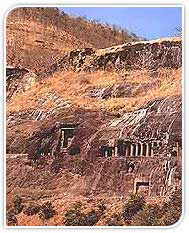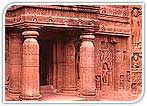
Cave
1:
This is one of the finest monasteries at Ajanta. Graciously
posed Bodhisattvas with elaborate headdresses flank the antechamber
doorway. On its either side are two of the best-known murals Bodhisattva
Padmapani and Bodhisattva Vajrapani holding a thunderbolt (right)
accompanied by attendants, divine musicians and flying figures.
The
left wall of the antechamber depicts the assault and temptation by Mara,
the god of passion, and on the right wall is the dark princess being
offered lotuses by a lady. In the shrine, the Buddha is seen in the
teaching position. Under his throne appears the Wheel of Life. The left
wall of the hall shows scenes from the Mahajanaka Jataka. To the right of
the rear wall are episodes from the Champeyya Jataka.
Cave
2:
It is remarkable for the painted ceiling with large
medallions, delicate bands of lotus flowers, scrollwork and abstract
geometric patterns. Episodes connected with the birth of the Buddha such
as the dream of his mother Maya, its interpretation by the priests and the
birth of Gautama occupy the left wall. Next of this is a representation of
the Miracle of Shravasti when the Buddha manifested himself in thousand
forms.
Cave 4:
Planned on a grandiose scale, but
never completed, this is the largest monastery at Ajanta. It has a central
doorway embellished with guardians, flying figures, maidens clutching
trees and also images of the Buddha and Ganas, or dwarfs, with garlands.
Six gigantic standing figures of the Buddha are carved in the walls of the
antechamber.
Cave 6:
Excavated on two levels, it
has a splendidly carved entrance. The lower hall has 16 octagonal columns.
In the shrine is the seated Buddha accompanied by standing Buddhas. The
upper hall has only one painting, depicting the gift by a monk.
Cave
7:
Unlike the other monasteries, this one contains only two small
porticos and does not have a hall. The shrine has a seated Buddha with a
halo carved on the back wall.
Cave 9 :

Rectangular
in plan, with a monolithic hemispherical Stupa in the center. Traces of
wall-paintings can be seen above which are figures of the Buddha in
various poses.
Cave 10 :
Probably the earliest cave
excavated at Ajanta. The paintings, though largely obliterated, reveal a
royal personage accompanied by soldiers, musicians and dancers,
worshipping the Bodhi Tree and the Stupa. Also of interest are the Jataka
tales on the right wall.
Cave 11:
Believed to be
excavated in phase II, it has an entrance with a lion-head at each end of
the threshold. The ceiling of the verandah is painted with trees, birds,
beast and geometric design. The walls of the hall are adorned with figures
of the Buddha.
Cave 12:
Among the earliest of
monasteries its doorways in the hall are topped with arched Chaitya window
motifs. Particularly noteworthy is a Brahmi inscription recording the gift
of the rear wall of the cell in the right corner of the hall.
 Cave
1:
Cave
1:  Rectangular
in plan, with a monolithic hemispherical Stupa in the center. Traces of
wall-paintings can be seen above which are figures of the Buddha in
various poses.
Rectangular
in plan, with a monolithic hemispherical Stupa in the center. Traces of
wall-paintings can be seen above which are figures of the Buddha in
various poses.